#Neo-Romanesque architecture
Text






Budapest 2007 (2) (3) (4) (5) (6) by Achim
Via Flickr:
(1) market hall
(2) Parliament
(3) Gellert bath
(4) fisher bastion
(5) souvenirs
(6) cellar restaurant called "FIASKO" but the food was great
#buildings#baroque architecture#city life#neo-romanesque architecture#romanesque revival#ceramics#garlic#eating places#people#hungary#budapest
6 notes
·
View notes
Text
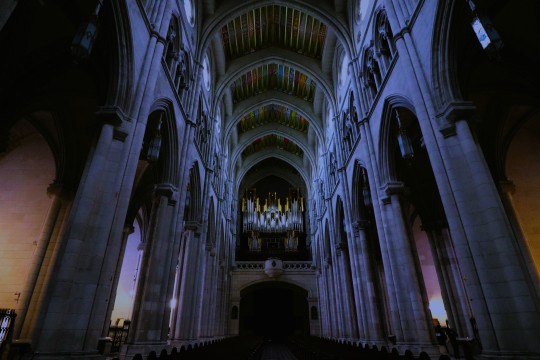
Catedral de la Almudena, Madrid
via
#catedral#cathedral#gothic#gothic cathedral#gothic aesthetic#architecture#old building#neo gothic#romanesque#neo romanesque#neo classical#gothique#art#gothic art#goth#madrid#catedral de la almudena#gothic architecture#goth architecture#goth aesthetic#interiors#historic architecture#spain#gothic revival#edited
178 notes
·
View notes
Photo

Fisherman’s Bastion, Budapest, 1971. From the Budapest municipal photography company archive.
231 notes
·
View notes
Text

Abside, Basilique Sainte-Anne de Beaupré, Québec, 2023.
Somewhat out of the ordinary for important Roman Catholic churches in Quebéc, this basilica is in a neo-romanesque rather than a neo-gothic style.
#architecture#neo romanesque#basilica#Sainte-Anne de beaupré#quebeéc#canada#2023#photographers on tumblr
9 notes
·
View notes
Text

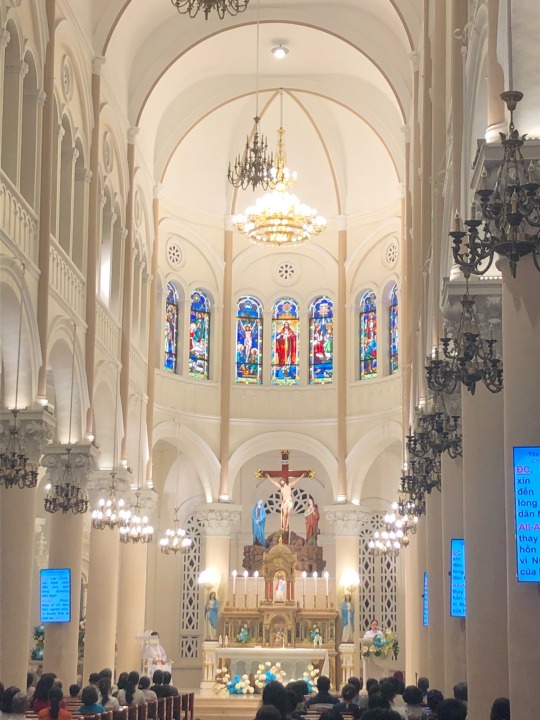



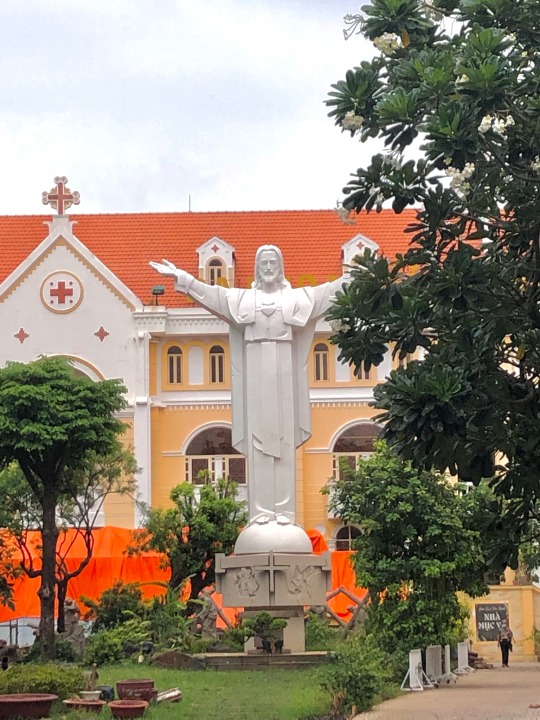

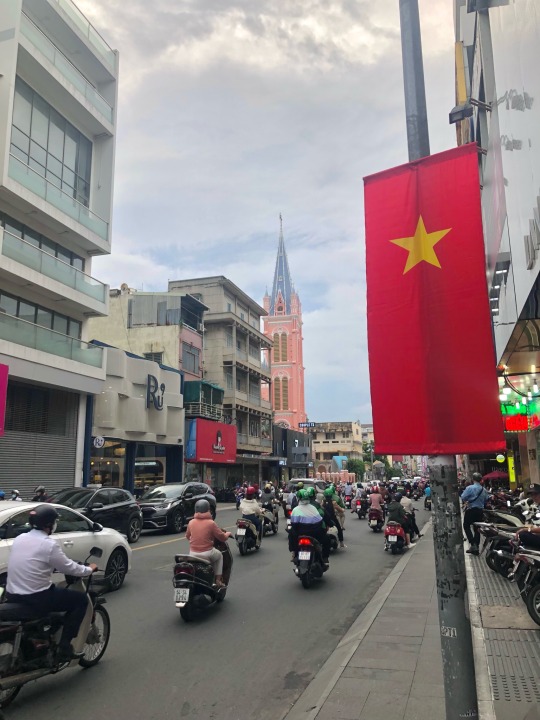

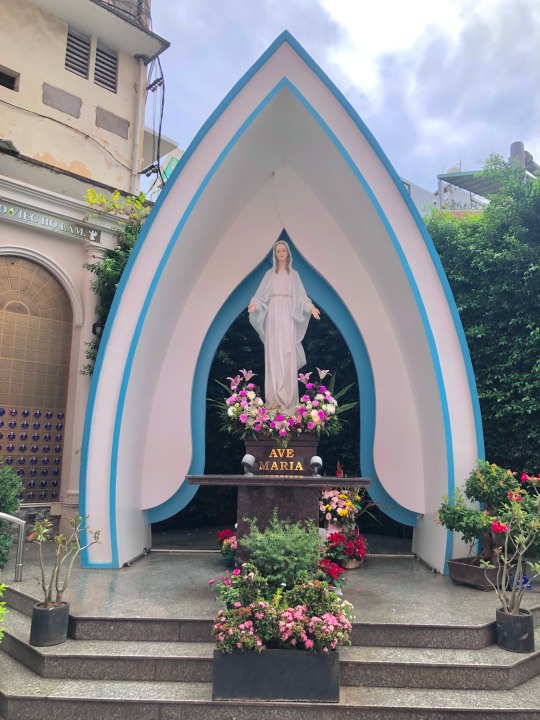
Tân Định church in Ho Chi Minh City, Vietnam. It was built during the French colonial period in the 1870s when Vietnam was part of French Indochina.
The architecture is mainly neo-Romanesque, but it also has some neo-Gothic and neo-Renaissance elements. It has been painted pastel-pink both on the exterior and interior since 1957, earning it the nickname "the pink church" (nhà thờ màu hồng).
140 notes
·
View notes
Text
why the "get back to tradition" culture twitter accounts never use romanesque architecture in their trad posting? it's always neo gothic and neo classicism.
17 notes
·
View notes
Text

The Fisherman’s Bastion is, in all likelihood, one of the most visited attractions in Budapest. This is the place where locals and tourists come to enjoy the city views. But what is the history of Halaszbastya? Why is the bastion so decorative rather than defensive as bastions are? First let’s see the quick facts in the short history, and then the extended version for those who want to learn more.
The Fisherman's Bastion was built between 1895 and 1902 as part of the series of developments that were to celebrate the 1000th birthday of the Hungarian state. Consequently, the Bastion was inspired by the architectural style of the early medieval times (Neo-Romanesque) approx. the year 1000, when the first Hungarian king started his rule. What is more, the 7 towers of the Halaszbastya features the 7 Hungarian chieftains who had led their tribes to the present day Hungary to settle down in 895, and the Statue of St Stephen (1906), the first Hungarian king (1000-1038). In short, it is a historical monument for the millennial Hungary.
The architect of the Halaszbastya is Frigyes Schulek, who also restored and redesigned the Matthias Church (Church of Our Lady). The construction of the Fisherman’s Bastion is intertwined with the restoration of the church: its historical architectural style was also picked to suit the church redesigned in a later medieval style (Neo-Gothic). The T shaped Bastion arrangement was to embrace the church while enhancing its beauty, and also to connect the Castle hilltop with the Danube side settlement, Fishtown aka Watertown.
The bastion was built as a viewing terrace with lookout towers on the base of a stretch of the castle walls (from the 17-18th century, built after the Buda Castle Siege). Rather than building sturdy thick stone walls, the intention was to present the locals with a communal panorama terrace, as the Buda Castle was no longer considered to be a military place. The romantic notion was to recall the old times, so Halaszbastya is often likened to a castle prop, which does not feel real. It was meant to be like a fairy tale, feel like history rather than be history. The ceremonial, wide stairs leading up to the Fishermen’s Bastion provide a dramatic entrance to the Castle Hill attractions and to the views of the Pest side sights. The stairway features further historical statues, from bottom to top: the Statue of John Hunyadi, the statue of St George Piercing the Dragon (the replica of the 15th century statue in Prague made by medieval Hungarian masters, the Kolozsvari Brothers), and the 10th century soldiers guarding the gate (at the top of the stairs, under the arch).
The Bastion was damaged in WW2, but soon restored by the son of the architect. By the 1980s, the walls of the Bastion became grey due to the household fumes, and urban air pollution. Also, many of the statues were in neglect (losing limbs, crumbling face, etc.). Thank to the Castle District municipality – urging the state and the capital to contribute to the enormous restoration costs – Halaszbastya is fully restored now.
7 notes
·
View notes
Text
(JTA) — More than 80 years after one of Germany’s most prominent synagogues was destroyed on Kristallnacht, the Jewish community of Hamburg has taken ownership of the building’s site and is set to begin rebuilding it.
The site of the Bornplatz Synagogue, a neo-Romanesque building dedicated in 1906 that had a 1,200-seat sanctuary and was once the largest synagogue in northern Germany, was officially handed over to leaders of the city’s Jewish community on Wednesday. At the ceremony marking that restitution, officials from the city of Hamburg cut up a copy of the Nazi-era Aryanization document that ordered the demolition of the synagogue.
“We apologize for coming to the decision so late to give them back their property,” Dirk Kienscherf, a local official from the center-left Social Democratic Party, said to representatives of the Jewish community at the ceremony.
The synagogue was burned during Kristallnacht, the series of pogroms in 1938 when Nazis destroyed synagogues and Jewish-owned stores across Germany. Its remains were later forcibly sold to the city and demolished, and an air raid bunker, for use only by Aryans, was built next door. At present, the empty site features a mosaic outlining the synagogue’s architecture, including its vaulted ceilings, that was laid in 1988 by artist Margrit Kahl.
“The Bornplatz Synagoge will rise again and become a monument of remembrance, serving as the visible center for the vibrant Jewish life in our city,” Rabbi Shlomo Bistrizky, a Chabad-Lubavitch movement emissary and chief rabbi of Hamburg, said in a statement.
The quest to rebuild the synagogue, more than eight decades after its destruction, began in the shop of a local antique dealer in the summer of 2020. Daniel Sheffer, an Israeli-born entrepreneur now based in Hamburg, was in the shop when he discovered a silver Torah crown engraved with a dedication to Markus Hirsch, the first rabbi of the Bornplatz Synagogue — which left him feeling “overwhelmed,” he told the Jewish Chronicle.
“But I also felt embarrassed and ashamed and angry, because I was being asked to buy back what was stolen from my ancestors,” he added. “That feeling lasted for days.”
Sheffer eventually bought the crown and brought it with him to more than 50 meetings with public officials and other potential supporters of his campaign, titled “No to antisemitism. Yes to the Bornplatz Synagogue.”
That effort led to the formation of the Initiative for the Reconstruction of the Bornplatz Synagogue, which Sheffer leads. The project secured more than $600,000 in German government funding to conduct a study evaluating the feasibility of rebuilding the synagogue. The construction itself will be funded by the Hamburg municipal government, the German government and private donations.
The pledges of public support for the project came following two more recent attacks on Jews in Germany: the 2019 shooting at a synagogue in the city of Halle, and an attack almost exactly a year later at the Hohe Weide synagogue in Hamburg during Sukkot, in which a Jewish student was seriously injured.
The Torah crown Sheffer bought is now housed at Hohe Weide synagogue. One of the Torah scrolls from the Bornplatz Synagogue, meanwhile, found its way to the United States in 1940 via Italy, rescued by a congregant, Joseph Bamberger. The Torah scroll continued to be used in the synagogues Bamberger and his family attended in Manhattan, and as of 2021, it is in the permanent collection of the city’s Museum of Jewish Heritage.
Some have argued that rebuilding the synagogue would lead the public to forget the atrocities of the Holocaust, while memorials like the one that currently exists in the square are a reminder of the community’s loss and destruction. “The mosaic communicates and commemorates the open wound of the building’s absence, and through it, the absence of what was once one of Western Europe’s most thriving Jewish communities,” Galit Noga-Banai wrote in Haaretz criticizing the reconstruction initiative.
Because of the unusual way the synagogue was destroyed — all of its rubble was pushed into the basement — some surprises have turned up during the excavation process. Those include colorful glass shards from the synagogue’s windows, which give a sense of what the building — whose image has been preserved in black-and-white photos — looked like, Northern German Broadcasting reported.
When the excavation is completed, an architectural competition for the design of the new synagogue will be held, and the bunker standing next to the synagogue will be demolished.
“This moment today is a turning point for our Jewish history in Hamburg,” Sheffer said, according to a local radio station. “It is the victory of justice and Jewish life in Hamburg over the barbarism of the Nazis.”
18 notes
·
View notes
Text
Architectural Finds, 06/24/2023
My walk today was a brief 20 minutes, I was meeting up with a friend from upstate for some chai who had come down the night before to stay with some other friends. We met up at the Chai Spot on Mott St. (which I definitely now recommend) and we relaxed in their backroom lounge with our chai's for 45 min or so. She eventually had to leave to catch her bus back upstate & I walked her to the subway stairs hugged her and said goodbye. Feeling the warm weather on my skin and the caffeine in my veins I decided to walk up Broadway, here were some of the architectural highlights.
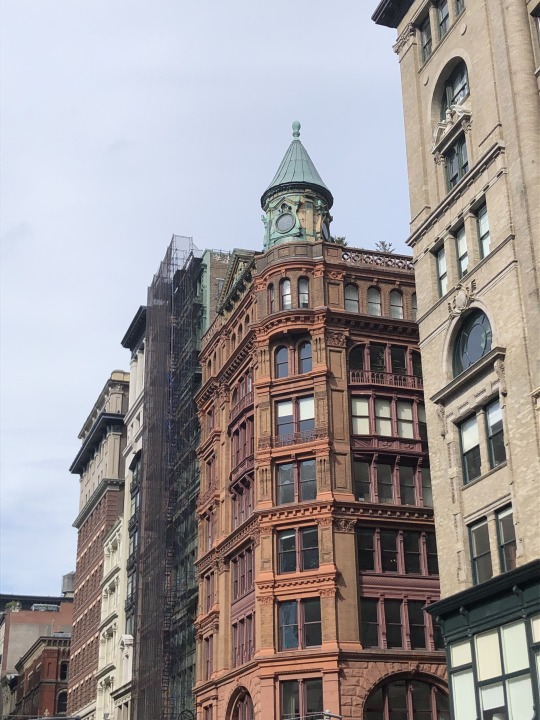
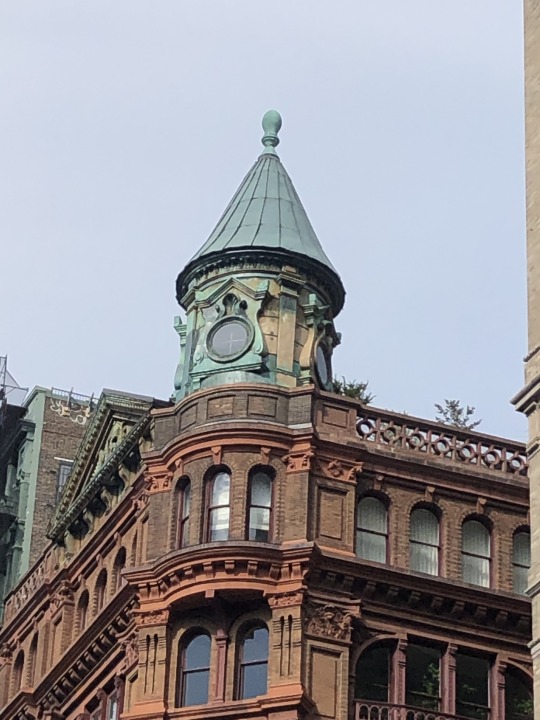
This cute turret room on the top of the building on the NE corner of Bleecker & Broadway. Doing the smallest ammount of googling I am finding out this was Peter Venkman's (Bill Murray) apartment in Ghostbusters 2???? ok.
It just looks like it would be such a whimsical little tower to hang your hair from, idk.
Building Facts: Built in 1891 as the Manhattan Savings Institution, also known as Bleecker Tower. Architect Stephen Decatur Hatch.
Built in the Romanesque Revival style with arches and ornaments, as well as the red sandstone and signature rough cut stone of this style on the base of the building (definitely why it caught my eye, I love Richardson Romanesque/romanesque revival).
The tower on top eludes my brief internet search, but if anyone has pictures of the inside please direct them to me.

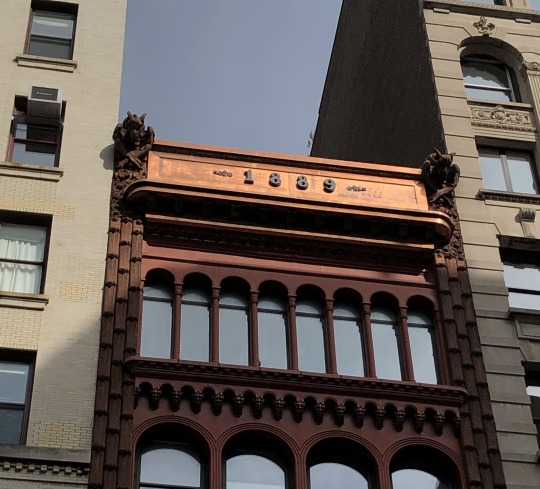
Next up we have this lil copper cutie who looks like it just got a face lift judging by the shiny copper facade on top. It is currently a FootLocker so hopefully they're treating her nice.
Building Facts: (obv) Built in 1889 by Architect Alfred Zucker.
The menacing gargoyles are cute.
(maybe more of an opinion than a fact, but) there used to be a bookstore called Shakepeare's on the bottom floor and the top floors were 1-per-floor studio spaces for artists to live/work in, & I wish that was the case today, not footlocker and high rent.

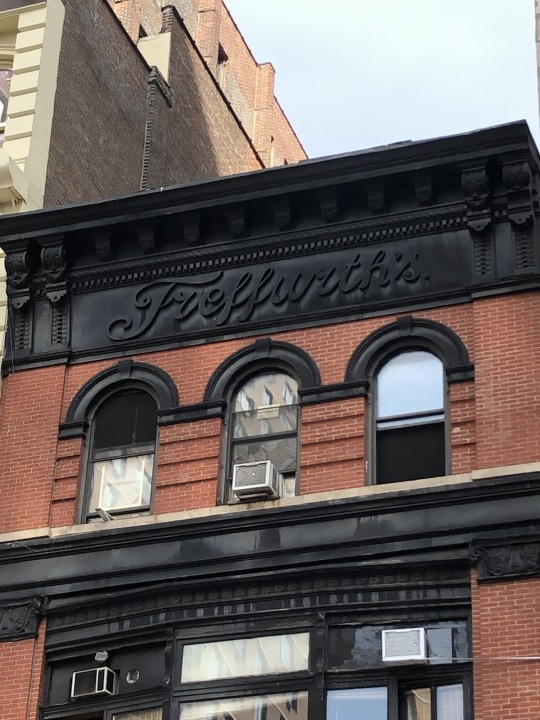
MOVING ON, we've got this pair of cuties. Don't they look like the best of friends holding hands ready to face the world side by side? These guys are 734 (left) and 732 (right) Broadway.
734: Built in 1872 by Architects David & John Jardine in Cast-Iron Neo-Grec style. Until ~2015, the facade had become a rusted brown/black mess until they cleaned and repainted it.
732: Built in 1854 by unknown.
This little building has a complicated past but ill try and summarize the small dig I just did on it. Originally it was a 3.5 peaked-roof building as a set of 3 houses for wealthy sisters (daughters of John Mason) from 732-736 designed by an undocumented architect. It underwent large renovations twice in its life, and one small renovation adding the Treffurth's sign on the roof cornice. The first renovation happened in 1885 by Henry Janeway Hardenbergh (god write a romance novel already would you) and allowed the introduction of E. A. Mac's bookstore to take the place of the earlier saloon on the bottom floor. It was then renovated in 1900 by Bruno W. Berger to the Cast-Iron more or less Renaissance Revival facade we see today.
-
Im going to keep these next ones brief because I'm beginning to lose steam :)

1 Astor Place
Built in 1883 by Architects Starkweather & Gibbs (they also designed the Potter Building). Brick & Terracotta above Cast-Iron ground floor facade.
Originally it was used as a hotel and boarding house with ground floor stores. The harsh vertical motifs on the exterior caught my eye, and I was drawn in even more by the harmony of the design elements and color choices.


10 Astor Place aka 444 Lafayette St
Built in 1876 by Architect Griffith Thomas to the same owner as the above building, Orlando B. Potter, who seemed to have impeccable taste in architecture.
I love the ornate implementation of the painted white Cast-Iron in the arches and pillar ornaments on this one. As well as the eye-popping contrast of the white paint on dark red brick, kind of a juxtaposed take on themes seen in the building above with the way the red and black elements seem to blend in together in harmony.

21 Astor Place aka Clinton Hall
Built in 1891 by George E. Harney.
Originally a Library for the New York Mercantile Library. I love the classic industrial look its such a strong look while they still tried to give elements of the facade some artistic nuance like in the arched windows and dark banding.

Only Caught the side of this Collonade building but doing more research on it, it's owned by the Blue Man Group????
Built 1831 by Seth Greer and historically home to family member's of the Astor & Vanderbilt families, it is the oldest building I took note of today.

And of course, how could I not be drawn into the Cooper Union Foundation building's charm. It stands seemingly so alone in the heart of Manhattan, close to a modern miracle.
Built in 1859 by Frederick A. Peterson in the (what I'm finding now to be called) Rundbogenstil German neo-Romanesque style.
I didn't realize it at the time but this picture also seems to be the back of the building. Still just such ornate and well-balanced design!
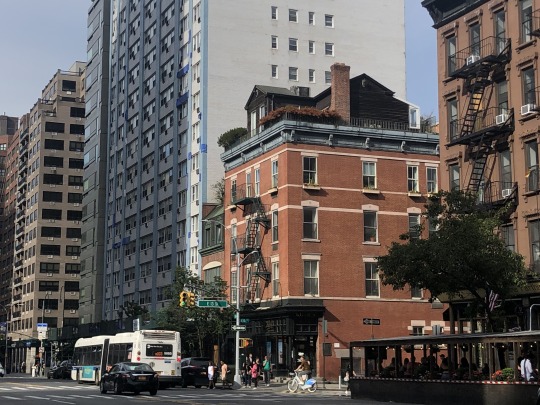


HONORABLE MENTIONS: This house on top of this building and the cute lil mansard moment next to it, which I searched and searched for but I cant seem to remember where it is.
Edit: I found it, there were street signs in the picture whoops. The one with the cottage is 203 E 13th Street also known as Pear Tree Place. And the little guy with the mansard roof is 109 3rd ave, both of them resting above Kiehls 3rd ave.
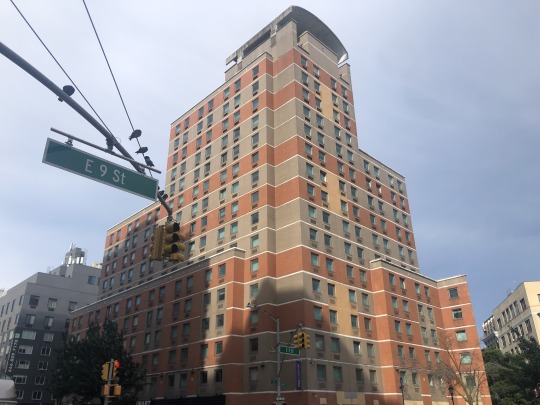
DISHONORABLE MENTIONS: This NYU Alumni building. Who designed you, they should be ashamed. What is going on with your offset, unbalanced terraces in the back? Awful. What was the point of all of these different colored brick patches?? Uncomfortable, awful. It looks like a neutral-toned Duplo set.
Built in 1986 and I cant even find the architect so you know they weren't very proud of it.
#architecture#manhattan#architect#Stephen Decatur Hatch#Alfred Zucker#Jardine#David & John Jardine#Henry Janeway Hardenbergh#Bruno W Berger#Starkweather & Gibbs#Orlando B Potter#Griffith Thomas#George E Harney#Seth Greer#Frederick A Peterson#Bleecker Tower#Manhattan Savings Institution#peter venkman#Ghostbusters II#Queen Anne#Romanesque#Richardson Romanesque#Gargoyles#Cast Iron#Neo-Grec#Greek Revival#Treffurths#Renaissance Revival#Astor Place#Clinton Hall
12 notes
·
View notes
Text

The Sacre Coeur over the rooftops of Paris
The Basilica of Sacré Coeur de Montmartre (Sacred Heart of Montmartre), commonly known as Sacré-Cœur Basilica and often simply Sacré-Cœur, is a Roman Catholic church and minor basilica in Paris, France, dedicated to the Sacred Heart of Jesus. It was formally approved as a national historic monument by the National Commission of Patrimony and Architecture on December 8, 2022. The basilica was designed by Paul Abadie, whose Neo-Byzantine-Romanesque plan was selected from among seventy-seven proposals. Construction began in 1875 and continued for forty years under five different architects. Completed in 1914, the basilica was formally consecrated in 1919 after World War
5 notes
·
View notes
Text
Exploring the Spiritual Heart: A Journey Through Church in Melbourne
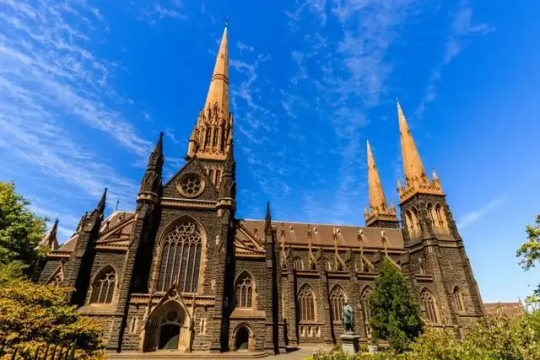
Introduction
Melbourne, the vibrant and culturally rich capital of Victoria, Australia, is renowned for its diverse architecture, dynamic art scene, and thriving multicultural community. Among its many attractions, the city is home to a remarkable array of churches, each offering a unique glimpse into Melbourne's spiritual heritage. These churches, ranging from historic cathedrals to modern worship centers, not only serve as places of religious significance but also as architectural marvels and cultural landmarks. In this article, we will embark on a comprehensive exploration of Church in Melbourne delving into their history, architectural styles, community roles, and much more.
St. Patrick's Cathedral: A Gothic Revival Masterpiece
St. Patrick's Cathedral stands as one of Melbourne's most iconic religious structures. Completed in 1939, this stunning example of Gothic Revival architecture features soaring spires, intricate stained glass windows, and a richly decorated interior. As the principal Catholic church of the Archdiocese of Melbourne, St. Patrick's Cathedral is not only a place of worship but also a significant historical and cultural monument.
St. Paul's Cathedral: An Anglican Jewel in the Heart of the City
Located opposite Federation Square, St. Paul's Cathedral is an Anglican church renowned for its striking neo-Gothic architecture. Designed by the English architect William Butterfield, the cathedral's construction began in 1880 and was completed in 1931. Its beautiful interior, adorned with mosaics and wood carvings, makes it a must-visit site for both worshippers and tourists.
Scots' Church: A Testament to Presbyterian Faith
Scots' Church, one of Melbourne's oldest, was established in 1838. This Presbyterian church, located on Collins Street, is a fine example of English Gothic architecture. Its stunning sandstone façade, exquisite stained glass windows, and impressive pipe organ attract visitors from all over the world.St. Mary Star of the Sea, situated in West Melbourne, is a Catholic church known for its grandiose Romanesque Revival style. Completed in 1900, the church boasts a majestic interior featuring high vaulted ceilings, ornate altars, and intricate frescoes. It continues to serve as a vital spiritual hub for the local community.
Holy Trinity Anglican Church: Embracing Diversity in East Melbourne
Holy Trinity Anglican Church, located in East Melbourne, is known for its inclusive approach and diverse congregation. The church's welcoming atmosphere, coupled with its beautiful Victorian Gothic architecture, makes it a significant spiritual and community center.
St. Francis' Church: The Oldest Catholic Church in Victoria
St. Francis' Church, founded in 1841, holds the distinction of being the oldest Catholic church in Victoria. Situated on Lonsdale Street, this historic church is a place of tranquility amidst the bustling city. Its serene interior, featuring beautiful stained glass and a peaceful garden, offers a perfect retreat for reflection and prayer.
Wesley Uniting Church: A Hub of Community Service
Wesley Uniting Church, located on Lonsdale Street, is not only a place of worship but also a center for community service and outreach. Established in 1858, this church is known for its distinctive neo-Gothic architecture and its commitment to social justice and support for the marginalized.
St. Michael's Uniting Church: A Modernist Marvel
St. Michael's Uniting Church, with its unique modernist design, stands out among Melbourne's religious buildings. Designed by architect Sydney Ancher in the 1950s, the church features an innovative open-plan interior that reflects the Uniting Church's progressive approach to worship and community engagement.
Sacred Heart Church: A Franco-Romanesque Beauty
Located in Carlton, Sacred Heart Church is a fine example of Franco-Romanesque architecture. Built in the early 20th century, this Catholic church is renowned for its beautiful stonework, intricate carvings, and vibrant stained glass windows. It remains a focal point for the local Catholic community.
St. John the Evangelist Church: A Hidden Gem in Toorak
St. John the Evangelist Church in Toorak is an Anglican church that combines traditional and modern elements in its design. The church's serene atmosphere, coupled with its beautiful gardens, makes it a peaceful haven for worshippers and visitors alike.
St. Peter's Eastern Hill: A Historic Anglican Parish
St. Peter's Eastern Hill, founded in 1846, is one of Melbourne's oldest Anglican parishes. The church's Gothic Revival architecture, complete with a bell tower and beautiful stained glass windows, reflects its rich history and enduring legacy as a place of worship and community gathering.
Our Lady of Victories Basilica: A Landmark of Camberwell
Our Lady of Victories Basilica in Camberwell is a Catholic church known for its striking Renaissance Revival architecture. Completed in 1918, the basilica's grand dome and majestic interior make it a prominent landmark and a center of spiritual life in the suburb.
Greek Orthodox Archdiocese of Australia: A Hub of Hellenic Culture
The Greek Orthodox Archdiocese of Australia, located in East Melbourne, serves as a vital spiritual and cultural center for Melbourne's Greek community. The church's Byzantine-style architecture, with its stunning mosaics and iconography, offers a rich visual and spiritual experience.
St. Ignatius' Church: A Jesuit Legacy in Richmond
St. Ignatius' Church in Richmond is a Catholic church established by the Jesuit order in 1867. The church's impressive Gothic Revival architecture and its active parish community make it a significant religious and cultural institution in Melbourne.
Church of All Nations: Embracing Multiculturalism in Carlton
The Church of All Nations in Carlton is an Anglican church that celebrates Melbourne's multiculturalism. Known for its inclusive and diverse congregation, the church plays a crucial role in promoting social harmony and cultural exchange in the community.
St. George's Anglican Church: A Community Pillar in Malvern
St. George's Anglican Church in Malvern is renowned for its beautiful Victorian Gothic architecture and its active engagement in community service. Established in 1869, the church continues to be a vibrant center of worship and outreach in the suburb.
Conclusion
Melbourne's churches are more than just places of worship; they are historical landmarks, architectural wonders, and community pillars. Each church, with its unique history, architectural style, and role in the community, contributes to the rich tapestry of Melbourne's cultural and spiritual landscape. From the Gothic spires of St. Patrick's Cathedral to the modernist design of St. Michael's Uniting Church, these sacred spaces invite us to explore and appreciate the diverse expressions of faith and heritage that make Melbourne a truly remarkable city. Whether you are a resident or a visitor, a journey through Melbourne's churches offers a profound and enriching experience, reflecting the city's enduring commitment to faith, community, and cultural diversity.
0 notes
Text
Why visit Manila from London?
Manila is the capital of the Philippines which is located in the Manila Bay on the island of Luzon. The city has a beautiful blend of ancient and modern architecture. You can easily book flights to Manila from London and explore the spectacular city of Philippines. The capital of the Philippines, Manila, has so much to offer to the tourists as there are several attractions in the city that you’ll love, you can also indulge in incredible and fun activities. The nightlife and food scenes in Manila are amazing and you must enjoy all the local dishes here to know about their culture and relish those beautiful local dishes.
Best Time to Visit Manila
The peak tourist season in Manila is during December, January, and February. You can enjoy a lot during these months but the city will be crowded with lots of tourists and you may end up spending more on hotels and flight tickets due to the rush. If you're looking for a budget-friendly trip to Manila, you can go during March, April, and May months as these are off-season months and you can experience moderate weather which is also ideal for exploring the city and you can enjoy flight and hotel bookings at reasonable rates.
Top places to visit in Manila
The following are the top places to visit in Manila:
San Agustin Church
The San Agustin Church is a Roman Catholic Church which was completed in 1607 making it the oldest church in the country. In 1976, the Philippines government named this church as a National Historical Landmark and it also comes under the World Heritage Site by UNESCO under the collective title of Baroque Churches of the Philippines. The architecture of the church represents the Augustinians in Mexico and it is beautiful inside out.
Fort Santiago
Fort Santiago is another landmark attraction in the city. It is a citadel that was built by a Spanish navigator in 1571. Fort Santiago now is a defense fortress located in Intramuros. The fort is a great depiction of the history of the country. There are many aspects that remind you of World War II. The history of Fort Santiago dates back to the British Rule, American Colonial Period, and World War II. Now, you can find several ruins and a historical park which is a must-visit tourist place.
Manila Cathedral
The Manila Cathedral is a Roman Cathedral Minor Basilica and it is also a cathedral church of the Archdiocese of Manila. This cathedral is dedicated to the Immaculate Conception of the Blessed Virgin Mary. This architectural beauty is a Neo-Romanesque style but has a Latin cross layout. The artwork inside the cathedral is by Italian artists and they're incredible. All tourists must visit this wonderful cathedral to seek blessings to appreciate the architecture of this monument with incredible historical significance.
Intramuros
Intramuros is a historic walled city of Manila which is 0.66 square km in size. It has a historic district that is centuries older, and several fortifications just like the Spanish colonization. It is a religious and education center in Manila and all tourists coming in flights to Manila from London must visit Intramuros. It is a park today with many historic monuments, there are many education centers, and shopping districts in Intramuros. Tourists can enjoy concerts, tours, and exhibitions here and have unending fun.
National Museum
The National Museum in Manila is an umbrella for all the national museums in the country. It includes anthropological, ethnographically, archaeological, and visual arts collections. It is one of the best places to visit for all the history buffs as you can gain a lot of knowledge about the history and culture of the Philippines here. There is a central and satellite museum inside the National Museum. The satellite museums comprises Region, Area, and Site museums. You can also check out the National Planetarium in this museum to add to your knowledge here.
Manila Bay
Manila Bay is one of the most beautiful attractions in the city. It is a natural harbor that also serves as the Port of Manila. Since it is a port, the Manila Bay is primarily used for trade and commerce with its neighboring countries. The region has a very diverse ecosystem which includes upland forests, sea grass, coral reefs, mudflats, mangroves, and sandy beaches. In these areas, there are 19319 birds across 99 species and 330 families. You can find around 794 hectares of mangroves in this region. The beautiful coral reefs are a major attraction for the tourists at the Manila Bay.
Manila Ocean Park
As the name suggests, it is one of the fun places to be in Manila. It is an oceanarium that has around 14000 sea animals across 277 species. It contains 3000 cubic meters of sea water to sustain the habitat for these marine animals. The oceanarium has a 220° curved walkway tunnel which is 25 meters long and the walkthrough to the oceanarium is 55 meters long. There are around seven sections in the Manila Ocean Park and these include educational activity area, shark viewing area, jellies exhibit, function rooms for events, etc. They also have Trails to Antarctica that includes a penguin park facility which is the first in the country. You can enjoy a lot at this park with your friends and family, especially kids.
Nightlife in Manila
Manila is both a modern and ancient city with amazing nightlife scenes for the tourists. You can find everything from food, music to dance clubs, bars, lounges, and pubs in Manila to satisfy the party animal inside you. Tourists coming on flights to Manila From London must not miss out on the beautiful shopping experience on the markets of the city, especially Black Market, during the nights. Here are some of the nightlife places you can check out in Manila to have a groovy time here:
XYLO at The Palace
Royal
Bank Bar
O Bar
Metrowalk
Toshie's Sports Bar
LIT Manila
Cove Manila
If you’re not so much into parties, you can also head outside during the nights and have fun doing some of the below activities in Manila:
You can go out shopping at the Black Market. Also the music and food here is lit for you to enjoy with your partners or friends.
Karaoke Bars and Lounges are a great option to listen to music, sing, dance, and dine.
Red Light Districts in Manila are also something that many tourists may enjoy.
You can end your night at the best diner in Manila with the local delicacies and some relishing desserts.
Major Airports and Airlines Flying In and Out of Manila
The major airports in Manila are:
Clark International Airport
Ninoy Aquino International Airport
Sangley Point Airport
Subic Bay International Airport
The major airlines in Manila are:
Cathay pacific
Korean Air
United Airlines
All Nippon Airways
Cebu Pacific
Royal Air Philippines
Thai Airways
Air Swift
Cebgo
Conclusion
Manila is a beautiful capital city of the Philippines that is a very popular tourist destination in the Southeastern part of Asia. There are many attractions in Manila that all tourists love exploring. The nightlife in the city is vibrant and the food scenes are delicious with lots of seafood options available here. If you're coming on flights to Manila from London, you must explore the Manila Ocean Park and Bay Region to have immense fun with your friends and family. The cultural blend in Manila is extraordinary and is evident in their historical monuments and cultural landmarks. Overall, you can have a fun-filled vacation in Manila.
Frequently Asked Questions:
What is the best time to visit Manila?
December, January, and February are the ideal time to visit Manila.
How do I get to Manila?
You can fly from anywhere in the world to Clark International Airport at Manila. You can also get to Manila by bus, train, or car from the nearby cities and towns.
Do I need a visa to visit Manila?
You can visit and stay in Manila without a visa for 30 days provided you comply with their entry requirements and regulations.
What currency is used in Manila?
Philippine Peso is the currency used in Manila.
What are the must-visit places in Manila?
San Agustin Church, Fort Santiago, Manila Cathedral, Intramuros, and National Museum are some of the must-visit places in Manila
What are some of the famous dishes of Manila?
Some of the famous dishes in Manila are: Halo-halo, Buko pie, Max's fried chicken, Kinilaw, Filipino fusion, and Kare-kare.
What are the top nightlife activities in Manila?
The top nightlife activities in Manila are- Black Market, Live Music Bars, City of Dreams Manila, Karaoke bars, lounges, and clubs.
What are the cultural scenes in Manila?
The cultural attractions in Manila are: Intramuros, Fort Santiago, San Agustin Church, and The Manila Cathedral.
How many days are enough to explore Manila?
You can plan between 3-5 days of trip to explore the entire Manila and have lots of fun.
What are the popular areas to stay in Manila?
Makati, San Juan, Ermita, Quezon City, and Malate District are some of the best places to stay in Manila for the tourists.
For More Information Please Visit:- https://www.worldtourstore.co.uk
0 notes
Text
Explore Peterborough’s Rich History: Landmarks and Heritage Sites
Nestled in the heart of Cambridgeshire, Peterborough is a city that effortlessly weaves the threads of history into the fabric of its modern existence. From its humble beginnings as a monastic settlement to its evolution into a vibrant urban centre, Peterborough boasts a rich tapestry of heritage sites and landmarks that offer a glimpse into its storied past. Join us on a journey through time as we explore Peterborough and its most fascinating historical gems.
Peterborough Cathedral
A Testament to Faith and Architecture
No exploration of Peterborough’s history is complete without a visit to its crowning jewel, Peterborough Cathedral. Peterborough Cathedral is one of the finest Norman cathedrals in England. This iconic structure is a testament to the enduring power of faith and architecture. Originally founded as a monastic settlement in 654 AD, the cathedral we see today dates back to the 12th century. The cathedral’s stunning Romanesque architecture, complete with its striking West Front, draws visitors from around the world. Inside, you will discover awe-inspiring vaulted ceilings, intricate stained-glass windows, and the final resting place of Catherine of Aragon, the first wife of King Henry VIII. Peterborough Cathedral offers guided tours that delve into its history, making it a must-visit for anyone interested in the city’s heritage.
Learn more: www.peterborough-cathedral.org.uk
Longthorpe Tower
A Medieval Masterpiece
Just a short distance from the city centre, Longthorpe Tower is a hidden gem that takes you back to medieval England. This charming three-story tower house, dating from the 14th century, boasts some of the finest and most complete surviving examples of medieval wall paintings in Northern Europe. Step inside and be transported to a time when knights roamed the countryside and lords and ladies held court. The wall paintings, which depict scenes from the medieval world, are a true marvel. Guided tours provide insights into the tower’s history and the stories behind these remarkable paintings.
Learn more: www.english-heritage.org.uk/visit/places/longthorpe-tower
Nene Valley Railway
A Journey on the Tracks of Time
For a more dynamic experience of Peterborough’s history, hop aboard the Nene Valley Railway. This heritage railway line stretches for seven and a half miles through the picturesque Nene Valley, offering a unique opportunity to travel back in time. Vintage steam and diesel locomotives pull meticulously restored carriages, taking passengers on a journey through the golden age of rail travel. The Nene Valley Railway offers a variety of events and themed rides throughout the year, from 1940s weekends to Christmas specials. It is a delightful way to experience history in motion and explore the scenic countryside surrounding Peterborough.n
Learn more: www.nvr.org.uk
Flag Fen Archaeology Park
A Window to Prehistory
For those intrigued by prehistoric times, Flag Fen Archaeology Park is a treasure trove of ancient history. This archaeological site dates back to the Bronze Age and is home to a wooden causeway and platform that were constructed over 3,000 years ago. Visitors can explore the reconstructed Bronze Age roundhouse and the fascinating artefacts discovered in the area, which provide insights into the daily lives of our distant ancestors. The park’s immersive exhibits and guided tours allow you to step into the past and connect with Peterborough’s prehistoric heritage.
Learn more: www.flagfen.org.uk
Peterborough Museum and Art Gallery
Chronicles of the City
To round off your exploration of Peterborough’s history, a visit to the Peterborough Museum and Art Gallery is essential. Housed in a stunning neo-Gothic building, the museum boasts an eclectic collection of artefacts, artworks, and exhibitions that span centuries. Discover the city’s past through exhibits on archaeology, natural history, and the local people who have shaped Peterborough. The museum frequently hosts special exhibitions and events, ensuring there is always something new to learn about this historic city.
Learn more: www.peterboroughmuseum.org.uk
As you explore Peterborough and its landmarks and heritage sites, you will gain a deeper appreciation for the city’s rich history and the people who have left their mark on its landscape. From medieval towers to prehistoric treasures, each site offers a unique glimpse into the past, making Peterborough a destination that history enthusiasts will cherish. So, lace up your walking shoes, pack your curiosity, and embark on a journey through time in this charming city that honours its heritage at every turn.
If you are looking for accommodation in Peterborough with on-site parking, a restaurant & bar, comfy rooms, and a convenient location, The Milestone Hotel is a perfect choice. Positioned just off Junction 16 of the A1(M), the hotel is ideally located 6 miles Southwest of Peterborough City Centre.
Love to explore? Discover and plan your perfect trip with local insights, travel guides and destination inspiration from AG Hotels Group. Sign up for our newsletters, here.
0 notes
Text
Santa Cruz Church: A Historic Gem in the Heart of Manila
Santa Cruz Church, nestled in the heart of Manila, stands as a testament to the rich history and cultural heritage of the Philippines. This iconic landmark, also known as the Archdiocesan Shrine of Our Lady of the Pillar, is a captivating blend of architectural beauty and religious significance that draws locals and tourists alike.
Historical Roots:
Dating back to the Spanish colonial era, Santa Cruz Church was originally built in 1608 by the Society of Jesus. Its foundations are steeped in the early days of Manila, making it one of the oldest churches in the country. Over the centuries, the church has withstood the test of time, surviving earthquakes, wars, and other historical upheavals.
Architectural Marvel:
The architecture of Santa Cruz Church is a captivating fusion of Baroque and Neo-Romanesque styles. The church's façade features intricate carvings and ornate details, showcasing the craftsmanship of Filipino artisans from centuries past. Its grandeur and elegance make it a standout landmark in the bustling urban landscape of Manila.
Religious Significance:
Santa Cruz Church holds immense religious significance for the Catholic community in Manila. The church is dedicated to Our Lady of the Pillar, a title associated with the Virgin Mary. Pilgrims and devotees flock to Santa Cruz Church to seek solace, offer prayers, and partake in religious ceremonies. The church plays a vital role in the spiritual life of the community, hosting various religious events throughout the year.
Cultural Hub:
Beyond its religious importance, Santa Cruz Church serves as a cultural hub, reflecting the diverse heritage of the Philippines. The church has been a witness to the country's history, and its walls echo the stories of the people who sought refuge and solace within its sacred confines. The surrounding area of Santa Cruz is a bustling district, adding to the vibrant cultural tapestry of the church's surroundings.
Preservation Efforts:
In recent years, efforts have been made to preserve and restore Santa Cruz Church to ensure that its architectural and historical significance endures for future generations. Restoration projects have focused on maintaining the original beauty of the church while addressing the wear and tear of time. The preservation of Santa Cruz Church is a testament to the commitment of the community to safeguard its cultural and religious heritage.
Tourist Attraction:
Santa Cruz the Abbey Church has become a must-visit destination for tourists exploring the rich history of Manila. Visitors are drawn to its captivating architecture, the solemnity of its religious ceremonies, and the palpable sense of history that permeates its walls. The church, surrounded by charming streets and historic buildings, provides a glimpse into Manila's past while remaining a vibrant part of its present.
0 notes
Text
Experiencing the Bustle of Ho Chi Minh City, Vietnam
Hello, fellow adventurers! If you’re reading this, you’re probably considering a trip to Vietnam. Today, we’re going to explore why Ho Chi Minh City, formerly known as Saigon, should be at the top of your travel list. So, buckle up and let’s dive in!
Why Ho Chi Minh?
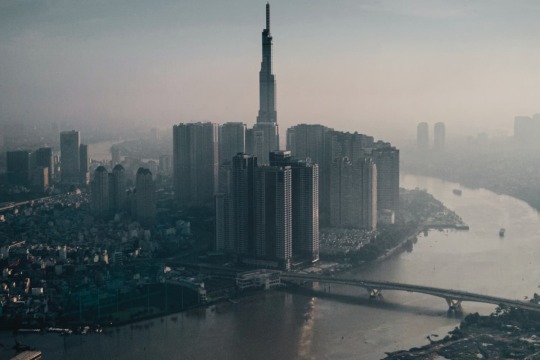
Photo by jet dela cruz on Unsplash
Ho Chi Minh City is a bustling metropolis that never sleeps. It’s a city where history and modernity coexist, where every street corner offers a new discovery. From its vibrant street food scene to its historical landmarks, Ho Chi Minh City is a treasure trove of experiences waiting to be discovered.
Must-Visit Attractions
Ben Thanh Market

Photo by Percy Pham on Unsplash
What’s special?
No visit to Ho Chi Minh City is complete without a trip to the Ben Thanh Market. This bustling market is a microcosm of the city itself - chaotic, vibrant, and utterly captivating.
How to reach?
The market is located in the heart of the city and can be reached by taxi, bus, or motorbike.
What to expect?
Here, you can find everything from fresh produce to souvenirs. Don’t forget to haggle!
War Remnants Museum

Image by Viet Nam National Authority of Tourism
What’s special?
The War Remnants Museum is a powerful reminder of the brutal history of the Vietnam War. It’s a sobering, yet important visit for anyone wanting to understand more about this period of history.
How to reach?
The museum is located at 28 Vo Van Tan, in District 3, Ho Chi Minh City. You can reach there by taxi or motorbike.
What to expect?
The museum offers an in-depth insight into the history of Vietnam while highlighting the horrors of war. The museum comprises a series of themed rooms in several buildings, with period military equipment placed within a walled yard.
Cu Chi Tunnels
What’s special?
The Cu Chi Tunnels offer a glimpse into the underground life of Vietnamese soldiers during the Vietnam War. This vast network of tunnels, stretching over 250 km, is a testament to the resilience and ingenuity of the Vietnamese people.
How to reach?
The tunnels are located about 70 km northwest of Ho Chi Minh City. You can get there by bus, taxi, or motorbike.
What to expect?
Here, you can explore the tunnels, learn about the ingenious traps used during the war, and even try some of the simple, yet hardy meals that the soldiers ate.
Notre-Dame Cathedral Basilica of Saigon
What’s special?
This stunning cathedral is one of the most iconic landmarks in Ho Chi Minh City. Built by French colonists, it’s a beautiful example of neo-Romanesque architecture.
How to reach?
The cathedral is located in the city centre and can be easily reached by taxi, bus, or motorbike.
What to expect?
Here, you can admire the beautiful architecture, take some great photos, and soak in the peaceful atmosphere.
Wrapping Up
Ho Chi Minh City is more than just a stopover. It’s a destination in its own right, offering a unique blend of history, culture, and urban energy. So, why wait? Start planning your trip now!
Ready to dive into the vibrant hustle and bustle of Ho Chi Minh City? Don’t wait! Embark on an unforgettable journey with the best and most affordable Ho Chi Minh City packages available at Fizota.com. Pack your bags, adventure awaits! Safe travels and see you in Vietnam!
0 notes
Text
Discovering Divine Beauty: The Most Beautiful Churches in Calgary, AB
Calgary, Alberta, is not only known for its stunning landscapes and vibrant city life but also for its rich cultural and religious heritage. As you explore this dynamic city, you'll find an array of architectural gems that stand as a testament to the diverse spiritual communities that call Calgary home. Join us on a virtual tour as we uncover the most beautiful churches in Calgary, AB.

St. Mary's Cathedral
Located in the heart of downtown Calgary, St. Mary's Cathedral is an iconic landmark that exudes timeless beauty. This Roman Catholic cathedral, built in the Gothic Revival style, features intricate stained glass windows, a majestic altar, and awe-inspiring vaulted ceilings. The cathedral's serene ambiance provides a peaceful retreat from the hustle and bustle of the city.

Knox United Church
A masterpiece of Neo-Gothic architecture, Knox United Church is a symbol of spiritual unity in Calgary. The church's stunning facade and intricate stonework make it a visual delight, while the interior showcases a blend of traditional and contemporary design elements. The warmth and inclusivity of Knox United Church extend beyond its architecture, making it a welcoming space for all.

Sacred Heart Church
Nestled in the vibrant Kensington neighborhood, Sacred Heart Church is a Roman Catholic parish with a rich history and a visually striking exterior. The church's blend of Romanesque and Gothic styles creates a unique aesthetic, and its intricate detailing captures the essence of sacred art. As you step inside, the tranquility of the space invites reflection and contemplation.

Welcome to Project Landscape, where Calgary's natural beauty meets expert craftsmanship. As the premier destination for transformative landscaping experiences, we pride ourselves on sculpting outdoor spaces that transcend the ordinary. Our passion lies in weaving nature's tapestry into the fabric of urban living, creating lush environments that captivate the senses and elevate the soul.
At Project Landscape, we understand that Calgary is not just a city; it's a living canvas waiting to be adorned with the splendor of nature. Our commitment to excellence in Calgary landscaping is reflected in every blade of grass we nurture and every stone we carefully place. As artisans of the outdoor realm, we craft personalized sanctuaries that seamlessly blend form and function.
Step into our digital garden at projectlandscape.ca, where innovation meets nature. Our website is more than a portal; it's a gateway to a world where dreams of the perfect outdoor haven come to life. Navigate through a gallery of awe-inspiring projects that showcase our dedication to redefining landscapes. From tranquil backyard retreats to vibrant garden oases, each project is a testament to our unwavering pursuit of perfection.
Discover a wealth of resources, including insightful blog posts and expert tips, designed to inspire and inform. Project Landscape is more than a service; it's a community where green enthusiasts, dreamers, and connoisseurs of outdoor elegance converge.
Our mission goes beyond creating picturesque landscapes; it's about fostering connections with nature that endure through the seasons. With a team of skilled professionals who share a passion for Calgary's unique climate and terrain, Project Landscape is your trusted partner in transforming outdoor spaces into living masterpieces.
Embrace the synergy of urban living and natural allure with Project Landscape—where Calgary landscaping becomes an art, and your outdoor dreams become reality.
Project Landscape
3511 64 Ave. SE, Calgary, AB T2C 1N3
+14032574059
https://www.projectlandscape.cahttps://www.google.com/maps?cid=11747008283103314784
0 notes